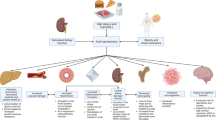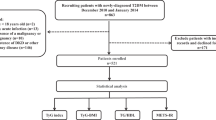Abstract
It is known that several metabolic abnormalities that favor stone formation have a strong dependence on environmental and nutritional factors. The incidence and prevalence of kidney stone is increasing while there has been a parallel growth in the overweight/obesity rate, and epidemiologic studies have shown a significant association between overweight/obesity and increased nephrolithiasis risk. The aim of this study was to assess if metabolic abnormalities observed in stone patients differ in relation to their BMI. We evaluated 817 renal stone formers (459 men and 358 woman) in an outpatient setting. They were all studied with a standard protocol (two 24 h urine collections and serum parameters) and classified according to their BMI in normal, overweight and obese and according to age in <50 or >50 year old. In the whole population we found that 58.7% were either overweight or obese: 39.4% (n = 322) were OW and 19.3% (n = 158) were OB. The proportion of overweight was significantly higher among men than women. In women of all ages regardless of BMI, hypercalciuria was the most prevalent diagnosis. Hyperuricosuria increased its prevalence significantly only in overweight and obese women <50 years of age (p < 0.01). Hypercalciuria was the predominant diagnosis in normal weight men of both age groups. Hyperuricosuria was the most frequent abnormality in overweight and obese men followed by gouty diathesis and both increased their prevalence significantly from normal weight to obesity and in both age groups (p < 0.05 and <0.01). We conclude that the only abnormalities that increased their prevalence significantly with increasing BMI were hyperuricosuria and gouty diathesis, the first one in men of all ages and women under 50 years of age, while the second one only in men.
Similar content being viewed by others
References
Stamatelou KK, Francis ME, Jones CA, Nyberg LM, Curhan GC (2003) Time trends in reported prevalence of kidney stones in the United States: 1976–1994. Kidney Int 63(5):1817
Flegal KM, Carroll MD, Ogden CL, Johnson CL (2002) Prevalence and trends in obesity among US adults, 1999–2000. JAMA 288:1723
Ogden CL, Carroll MD, Curtin LR, McDowell MA, Tabak CJ, Flegal KM (2006) Prevalence of overweight and obesity in the United States 1999–2004. JAMA; 295:1549–1555
West B, Luke A, Durazo-Arvizu RA, Cao G, Shoham D, Kramer H (2008) Metabolic syndrome and self-reported history of kidney stones: the National Health and Nutrition Examination Survey (NHANES III) 1988–1994. Am J Kidney Dis 51(5):741
Sakhaee K, Maalouf NM (2008) Metabolic syndrome and uric acid nephrolithiasis. Semin Nephrol 28:174
Curhan GC, Willett WC, Rimm EB, Speizer FE, Stampfer MJ (1998) Body size and risk of kidney stones. J Am Soc Nephrol 9(9):1645
Taylor EN, Stampfer MJ, Curhan GC (2005) Obesity, weight gain, and the risk of kidney stones. JAMA 293:455
Powell CR, Stoller ML, Schwartz BF, Kane C, Gentle DL, Bruce JE, Leslie SW (2000) Impact of body weight on urinary electrolytes in urinary stone formers. Urology 55(6):825
Siener R, Glatz S, Nicolay C, Hesse A (2004) The role of overweight and obesity in calcium oxalate stone formation. Obes Res 12:106
Negri AL, Spivacow FR, Del Valle EE, Forrester M, Rosende G, Pinduli I (2008) Role of overweight and obesity on the urinary excretion of promoters and inhibitors of stone formation in stone formers. Urol Res 36:303
Negri AL, Spivacow R, Del Valle E, Pinduli I, Marino A, Fradinger E, Zanchetta JR (2007) Clinical and biochemical profile of patients with “pure” uric acid nephrolithiasis compared with “pure” calcium oxalate stone formers. Urol Res 35:247
Daudon M, Lacour B, Jungers P (2006) Influence of body size on urinary stone composition in men and women. Urol Res 34:193
Ekeruo WO, Tan YH, Young MD, Dahm P, Maloney ME, Mathias BJ, Albala DM, Preminger GM (2004) Metabolic risk factors and the impact of medical therapy on the management of nephrolithiasis in obese patients. J Urol 172:159
Costa-Bauzá A, Ramis M, Monesinos V, Cone A, Pizá P, Pieras E, Grases F (2007) Type of renal calculi: variation with age and sex. World J Urol 25(4):415–421
Taylor EN, Curhan GC (2006) Body size and 24-h urine composition. Am J Kidney Dis 48(6):905
Maalouf NM, Sakhaee K, Parks JH, Coe FL, Adams-Huet B, Pak CY (2004) Association of urinary pH with body weight in nephrolithiasis. Kidney Int 65(4):1422–1425
Chobanian MC, Hammerman MR (1987) Insulin stimulates amoniagenesis in caninine renal proximal tubules segments. Am J Physiol 253:F1171–F1177
Gesek FA, Schoolwerth AC (1991) Insulin increases Na(+)–H + exchange activity in proximal tubules from normotensive and hypertensive rats. Am J Physiol Renal Physiol 260:695
Cameron MA, Maalouf NM, Adams-Huet B, Moe OW, Sakhaee K (2006) Urine composition in type 2 diabetes: predisposition to uric acid nephrolithiasis. J Am Soc Nephrol 17(5):1422–1428
Abate N, Chandalia M, Cabo-Chan AV Jr, Moe OW, Sakhaee K (2004) The metabolic syndrome and uric acid nephrolithiasis: novel features of renal manifestation of insulin resistance. Kidney Int 65(2):386
Nouvenne A, Meschi T, Guerra A, Allegri F, Prati B, Borghi L (2008) Role of BMI on lithogenic risk in women with idiopathic calcium nephrolithiasis and controls. Urol Res 36:223
Lemann J Jr, Pleuss JA, Worcester EM, Hornick L, Schrab D, Hoffmann RG (1996) Urinary oxalate excretion increases with body size and decreases with increasing dietary calcium intake among healthy adults. Kidney Int 49(1):200–208
Author information
Authors and Affiliations
Corresponding author
Rights and permissions
About this article
Cite this article
del Valle, E.E., Negri, A.L., Spivacow, F.R. et al. Metabolic diagnosis in stone formers in relation to body mass index. Urol Res 40, 47–52 (2012). https://doi.org/10.1007/s00240-011-0392-8
Received:
Accepted:
Published:
Issue Date:
DOI: https://doi.org/10.1007/s00240-011-0392-8




